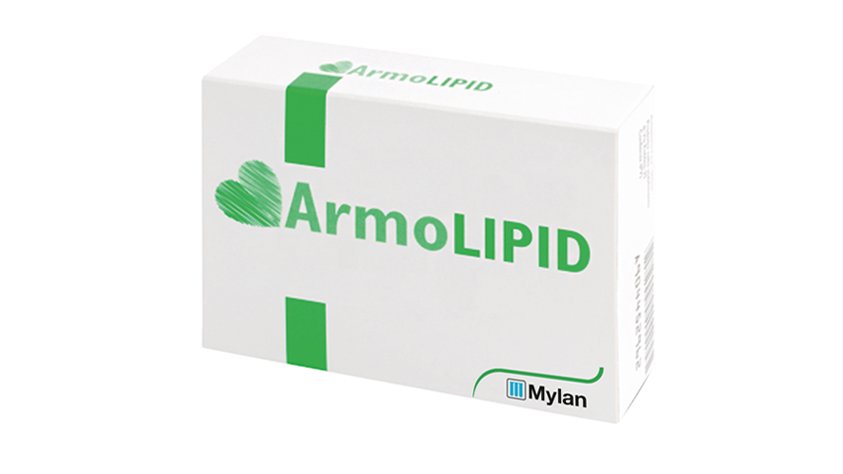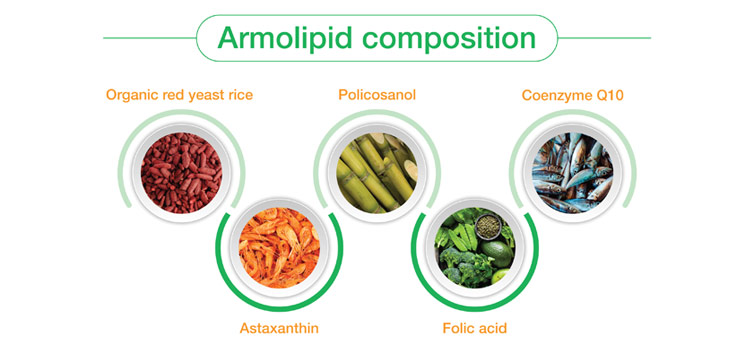ArmoLIPID®
Food supplements have proven to be effective in managing cholesterol levels, when used in addition with a healthy lifestyle and dietary modification.

Food supplements consist of ingredients that may give health benefits. ArmoLIPID® associated to an appropriate diet has shown to be more effective than diet alone in reducing abnormal cholesterolemia, supporting its use to help control hypercholesterolemia in association with a dietary modification and a healthy lifestyle9.
There are two formulations: ArmoLIPID® and ArmoLIPID® Plus. This article details about ArmoLIPID®.
Discover more about ArmoLIPID Plus®.

Constituents of ArmoLIPID®
The quantity of each constituent in one tablet of ArmoLIPID® is mentioned below (Table 1)2:
Table 1: Average quantity of each constituent per tablet of ArmoLIPID®
|
Average analysis |
Per 1 tablet |
|
Red yeast rice (Monascus purpureus) equivalent to monacolin |
200 mg 3 mg |
|
Microalgae (Haematococcus pluvialis Flotow) equivalent to astaxanthin |
20 mg 0.5 mg |
|
Policosanol |
10 mg |
|
Folic acid |
200 μg* |
|
Coenzyme Q10 |
2.0 mg |
*Equivalent to 100% of the Nutrient Reference Value.
Red Yeast Rice
Red yeast rice is produced by fermentation of the rice Oryza sativa with a strain of mould (Monascus purpureus). Red yeast rice contains Monacolin K, which has a chemical structure belonging to the class of statins which are involved in cholesterol metabolism. It inhibits competitively the activity of 3-hydroxy-3-methylglutaryl–coenzymeA (HMG-CoA) reductase, a key enzyme in cholesterol biosynthesis1,3,7.
Folic Acid
Folic acid contributes to the normal metabolism of homocysteine. Homocysteine is a substance physiologically produced in the organism following the metabolism of the aminoacid methionine, which is introduced in our organism with the diet. Homocysteine is then remethylated to methionine. If this process of reconversion does not take place, or if it takes place only partially, untransformed homocysteine accumulates in the organism and may be harmful for several organs, particularly for the health of the cardiovascular system1. Folic acid is able to reduce homocysteine plasma levels7,8. Armolipid contains the physiological daily allowance of Folic acid1.
Policosanol
It is a combination of aliphatic primary alcohols contained in the waxy matrix of the sugar cane (Saccharum Officinarum), in rice bran (Oryza sativa) and in beeswax (Apis mellifera), Policosanol may have the capability to mildly inhibit the synthesis of HMG-CoA reductase1,7. In an in-vitro experimental model, low-density lipoprotein (LDL) processing was markedly enhanced by policosanol, even when cholesterol synthesis was not strongly inhibited4.
Coenzyme Q10
It is a naturally occuring quinone found in the majority of aerobic organisms. An adequate reserve of Coenzyme Q10 (CoQ10) is essential for oxide-reduction reactions involved in ATP synthesis and to prevent LDL peroxidation1,5,7.
Astaxanthin
It is a carotenoid, belonging to the class of terpenes, derived from the microalga Haematococcus pluvialis, Astaxanthin significantly lowered LDL cholesterol and improved oxidative stress biomarkers of lipid peroxidation and antioxidant activity in overweight healthy subjects1,6.
Mode of Administration and Precautions
Mode of administration: the recommended dose is one tablet daily to be taken orally. In case of swallowing difficulty, it is suggested to split the tablet in two parts to be taken with a glass of water1.
Precautions1:
- Do not exceed the recommended daily dose
- Keep out of the reach of young children
- Do not use during pregnancy, lactation
- Do not use in combination with hypolipidaemic drugs
- It is advised to consult a physician for the product use
Food supplements must not be considered as substitutes of a varied, balanced diet and a healthy lifestyle.
Gastrointestinal disorders and muscular pain may occur taking ArmoLIPID Plus, mainly in subjects intolerant to statins. A doctor should be consulted if muscular pain occurs.
Hodnotenie pacienta
Hodnotenie pacienta s vysokou hladinou cholesterolu zahŕňa zistenie príčiny a rizikového faktora, ktoré s tým súvisia.
Preventívne stratégie a liečba
Pri kontrole hladín cholesterolu môžu pomôcť rôzne intervencie, od úpravy životného štýlu až po farmakologickú liečbu.
Posúdené lekárom zo spoločnosti Viatris 01 December 2020
-
Zdroje
- Mylan. ArmoLIPID®. English leaflet.
- Mylan. ArmoLIPID®. English leaflet (Label of the box).
- Nguyen T, Karl M, Santini A. Red Yeast Rice. Foods. 2017;6(3):19.
- Menendez R, Fernandez SI, Del Rio A, et al. Policosanol inhibits cholesterol biosynthesis and enhances low density lipoprotein processing in cultured human fibroblasts. Biol Res. 1994;27(3–4):199-203.
- Saini R. Coenzyme Q10: The essential nutrient. J Pharm Bioallied Sci. 2011;3(3):466–467.
- Choi HD, Youn YK, Shin WG. Positive effects of astaxanthin on lipid profiles and oxidative stress in overweight subjects. Plant Foods Hum Nutr. 2011;66(4):363–369.ù
- Barrios V, et al. A nutraceutical approach (ArmoLIPID PLUS) to reduce total and LDL cholesterol in individuals with mild to moderate Dyslipidaemia: Review of the clinical evidence. Atherosclerosis Supplements. 2017; 24:1–15.
- Vijayakumar A, Kim EK, Kim H, et al. Effects of folic acid supplementation on serum homocysteine levels, lipid profiles, and vascular parameters in post-menopausal Korean women with type 2 diabetes mellitus. Nutr Res Pract. 2017;11(4):327–333.
- Cicero F.G. Benvenuti C., and ARMoweb study Group. Efficacy of a red yeast rice based nutraceutical in large subgroups of hypercholesterolemic subjects in every day clinical practice. Mediterr J Nutr Metab 2010, 3:3239-246.




